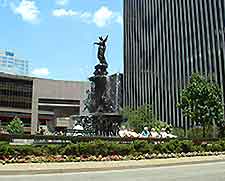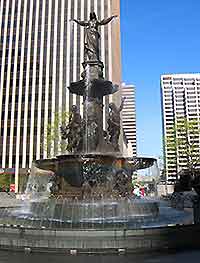Cincinnati History Facts and Timeline
(Cincinnati, Ohio - OH, USA)

If there was ever a city built upon a river, it is Cincinnati. First the Ohio River and then the Erie Canal opened up this fast-growing trade and transport center, with major manufacturing ports to the south and east.
As the prosperity flowed in, Cincinnati's downtown core flourished with grand buildings, professional sports teams and most recently, a slew of new cultural venues and modern riverside entertainment districts.
A River Runs Through It
Like most early American settlements, Cincinnati began life as a trading post along the mighty Ohio River. The history of Cincinnati got going in 1802 when it was formed as a village, later becoming an incorporated city in 1819. Two major events helped to shape the young town's future - the arrival of steam navigation for boats along the Ohio River and the completion of the Miami and Erie Canal in 1827.
Trading Partners
The mid-1800s were the boom years in Cincinnati's history and its population swelled due to easy access via the river and canal network. The city did a roaring trade with towns farther along the river in the south, which used the Ohio River and the Erie Canal to transport goods to
New York and the east coast of America.
The Power of Rail
When the railroad finally made its way to Cincinnati in 1836, the city's trading prospects expanded even further. The Little Miami Railroad connected the city to the Lake Erie Railroad and the Mad River, offering new access to Lake Erie's ports on Sandusky Bay, as well as another major river for navigation. The prosperity that followed allowed Cincinnati to build its first streetcar system and by 1872, the entire city was laid out for public transportation.

Expanding its Boundaries
Towards the end of the 1800s, the history of Cincinnati continued to be shaped by industry and trade. Wealth was spread around the city, helping to create monuments that survive today, such as the Tyler Davidson Fountain. Procter and Gamble, the manufacturer of the wildly popular Ivory Soap, was based in Cincinnati, while other major industrial companies arrived to help keep the city in relatively good shape during the upheavals of the Great Depression.
Iconic structures like the Bell Telephone Building and the Union Terminal on Western Avenue, which today is the Cincinnati Museum Center, kept the downtown core growing in style right through the World Wars and into the modern era. Cincinnati's fascination with sports carried on through the 20th century and in the 1970s, the city built both the Riverside Stadium and the Riverfront Coliseum to house its talented professional baseball and football franchises, respectively. These sporting venues have since been replaced with the modern Paul Brown Stadium and the Great American Ball Park, two of America's newest and most state-of-the-art facilities.
The city has continued to expand into cultural areas, opening the Rosenthal Center for Contemporary Art in 2003 and the National Underground Railroad Freedom Center in 2004. As the city's expansive riverfront area continues its facelift known as The Banks, it looks as if Cincinnati's next chapter in history will be just as successful as its past ones.
 If there was ever a city built upon a river, it is Cincinnati. First the Ohio River and then the Erie Canal opened up this fast-growing trade and transport center, with major manufacturing ports to the south and east.
If there was ever a city built upon a river, it is Cincinnati. First the Ohio River and then the Erie Canal opened up this fast-growing trade and transport center, with major manufacturing ports to the south and east.